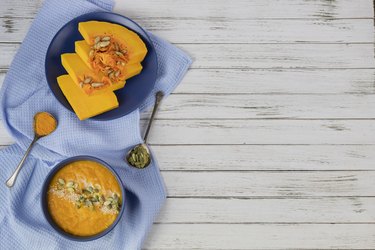
More isn't always better when it comes to certain nutrients, and in the case of sulfur, certain individuals — such as those with ulcerative colitis — might want to follow a low-sulfur diet.
If you fall into that category, you're probably curious about what low-sulfur foods are good to eat and which high-sulfur foods you should avoid. Here's what you should know about sulfur in your diet.
Video of the Day
Video of the Day
What Is Sulfur?
Sulfur is a mineral that derives from protein, as explained in an article published by the journal Nutrition & Metabolism back in November 2007 exploring how much sulfur the average person gets. As the article notes, the essential amino acid methionine is a common dietary source of sulfur.
It should come as no surprise then that high-protein diets tend to be the ones with the most sulfur. Per the article's guidelines, the recommended dietary allowance of methionine is about 14 milligrams a day per kilogram of body weight; thus, a person who is 70 kilograms (154 pounds) would need about 1.1 grams of methionine a day regardless of other factors such as gender, age or activity level.
People who follow a high-protein diet average around 6.8 grams of sulfur amino acids a day. People who are eating a calorie-restricted diet will often have lower intakes, but that doesn't mean they necessarily have a low-sulfur diet. A high-protein, low-calorie diet typically yields 5 grams a day, whereas a dieter might consume 3.5 grams a day. Vegans might consume as little as 2.3 grams a day, still more than twice the recommended 1.1 grams of methionine a day.
Why a Low-Sulfur Diet?
As explained by a January 2016 study published in the World Journal of Gastroenterology, foods that are high in sulfur are among the products that could exacerbate inflammatory bowel diseases like ulcerative colitis and Crohn's disease. Although you should talk to your doctor or a gastroenterologist about how much food you should eat and what low-sulfur foods you should focus on, it is helpful to know which foods are high in sulfur and which ones are low.
Read more: List of Foods High in Sulfur
In some cases, it's relative. For meat eaters, fish and chicken are frequently considered low-sulfur foods compared with beef. According to the USDA, 1 ounce of ground beef has 191 milligrams of methionine, whereas the same amount of boneless salmon has only 154 milligrams.
However, both of those foods are significantly higher than plant sources, which, because they have a lower protein content, tend to be low-sulfur foods. As far as plants go, cruciferous vegetables have relatively high levels of sulfur, such as broccoli, which has 35 milligrams of methionine per 1 cup serving. That's nearly twice what other vegetables and fruits have:
- Butternut squash: 17 milligrams per 1 cup serving
- Cantaloupe: 21 milligrams per 1 cup serving
- Watermelon: 9 milligrams per 1 cup serving
- Grapefruit: 14 milligrams per 1 cup serving
- Apples: 1 milligram per 1 cup serving
Each of these could safely be considered a low-sulfur food.
Just because a person isn't eating meat doesn't mean they're following a low-sulfur diet. Animal-based protein sources tend to be high in methionine, such as eggs, which have 190 milligrams of methionine each, and whole cow's milk, which has 203 milligrams per cup.
Even plant-based sources of protein can be high — soy protein concentrate has 231 milligrams per ounce. Compare that with garbanzo beans, which have 264 milligrams per 1 cup. Even though these are plant-based sources of protein, the methionine content is still high.
- Nutrition and Metabolism: “Are We Getting Enough Sulfur in Our Diets?”
- USDA: “Eggs (Raw)”
- USDA: “Whole Milk”
- USDA: “Broccoli”
- USDA: “Butternut Squash”
- USDA: “Cantaloupe”
- USDA: “Watermelon”
- USDA: “Apples”
- USDA: “Salmon”
- USDA: “Broiled Ground Beef Patty”
- USDA: “Soy Protein Concentrate”
- USDA: “Garbanzo Beans”
- Word Journal of Gastroenterology: "Diet and Nutritional Factors in Inflammatory Bowel Diseases"
- "Nutrition Journal"; Associations Between Diet and Disease; Elizabeth Magee; 2005